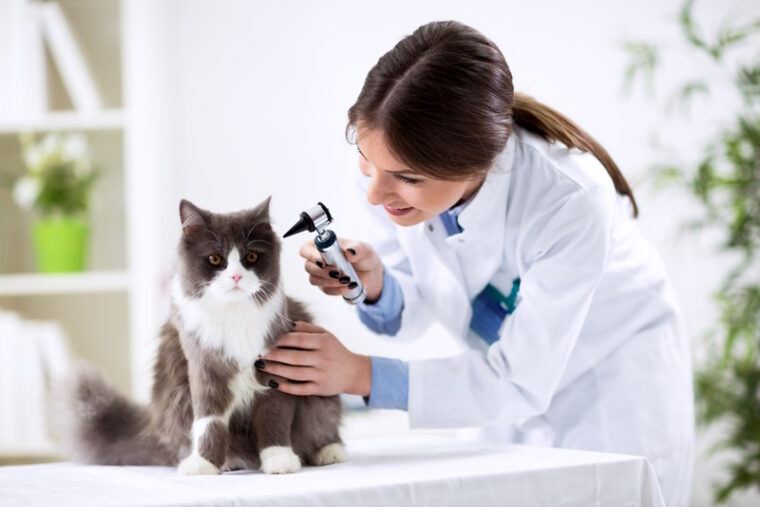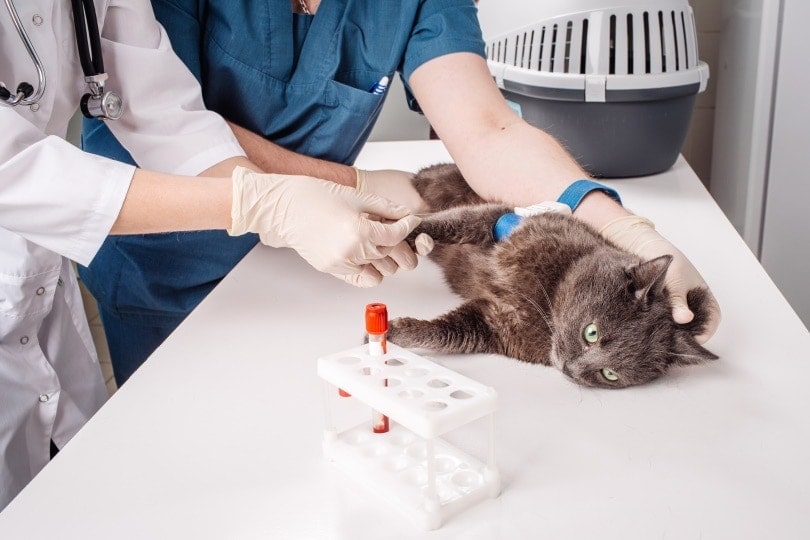
Click Below to Skip Ahead
Cancer can form in any part of the body, so any structure in the ear can also develop cancer, including the lining of the ear canal, the earwax glands, the connective tissues, or the skin on the ear tips. Ear cancer, in general, tends to be pretty bad news.
However, when most people refer to ear cancer in cats, they are typically thinking of a specific type called squamous cell carcinoma, the most common type of ear cancer.
As a result, this article will focus mostly on squamous cell carcinoma but will also touch on other less common types of ear cancer in cats.
What Is Squamous Cell Carcinoma?
Squamous cell carcinoma is a form of skin cancer. The cancerous cells slowly spread along the skin, where they form visible tumors, lumps, bumps, and scabs that usually are the first sign of the disease. As the cancer develops and grows, it eventually spreads to their parts of the body, such as the lungs, where it then becomes deadly. While it spreads to other parts of the body less quickly, once they do spread, they are much harder to treat.
But if it is treated in time, squamous cell carcinoma can be successfully treated.
What Are the Signs of Squamous Cell Carcinoma?
Squamous cell carcinoma commonly develops on the tips of the ears. However, it can also form in other places, particularly around the face, such as in the following places:
Cats get all sorts of lumps and bumps on their face, and it can be confusing to tell the difference between a scab caused by a cut and a scab caused by cancer. The number one tell-tale sign, though, is that the scab or sore does not heal quickly, or it does heal but comes back in the same place right away.
What Are the Causes of Squamous Cell Carcinoma?

The causes of cancer are very unclear and confusing. This is probably because cancer is rarely caused by just one thing. Usually, it is caused by many things all coming together in the right way.
The best way to describe the causes of cancer is to describe the risk factors—the things that increase the chances of a cat developing cancer. The more risk factors a cat has, the greater the chances of them developing squamous cell carcinoma.
How Do I Care for a Cat with Squamous Cell Carcinoma?
It is treatable if caught early enough but deadly if left untreated. The earlier a vet examines and gets a diagnostic sample of squamous cell carcinoma, the better.
If a scab or lump forms on your cat’s face, bring them to the vet. They will need to take a sample to test it for cancerous cells—the only way to know for sure what it is.
If it is early enough, surgery removes the cancerous lump and some of the surrounding tissue to make double sure all the cancerous cells are removed. Some surgeons will remove the tumor with cryotherapy, which freezes off the lesion. Chemotherapy may also be a treatment option. And even radiation therapy may be used.
Each cancer and each cat will be different, so their cancer treatment will vary. Selecting the right treatment option is an involved conversation with your vet. It is stressful and scary, but the best way to know that you are doing the right thing is to explore the options together and come up with an individualized plan specific for your cat.
Frequently Asked Questions (FAQs)
What is the difference between a FNA and a biopsy?
Both are medical tests that examine cells for signs of disease. In both cases, the collected cells are examined under a microscope.
A biopsy is where a section of tissue is cut out and examined. A fine needle aspirate is where just a needle’s worth of tissue is removed. A biopsy takes a bigger sample, so it is more likely to have enough cells to form a more complete diagnosis. A fine needle aspirate takes fewer cells and so is less likely to be definitively diagnostic.
However, a fine needle aspiration is much easier to perform. It is less painful. It usually does not require pain medication or sedation. A biopsy creates an open wound that is more likely to get infected and may need your cat to be sedated to retrieve it.

If I live in an area with a high UV risk, is my cat affected?
Probably, but the science is not advanced enough to know for sure. But chronic sun exposure and severe sunburns do seem to be significant risk factors, so increased UV exposure is not ideal.
What are other types of ear cancer in cats?
As mentioned above, cancer can develop anywhere in the body and anywhere in the ear. And as discussed in the above section, the causes of cancer are still obscure, confusing, and complex, especially when examining a structure as complicated as the ear, which contains organs, bones, skin, glands, muscles, and even ear-specific tissues, like eardrums.
Cancers of the ear can develop from any of these tissues. And the only risk factor that may perhaps increase your cats’ chances of developing a mysterious ear cancer is chronic ear inflammation—usually in the form of ear infections.
Many cats spend their entire life waxing and waning ear infections, and this can possibly predispose them to cancer in the ear. However, more research is needed. Further examining all the different, more obscure, less common types of ear cancer is too large and boring of a project here today.

Summary
Just know that it’s important to keep your cats’ ears healthy, clean, and sunburn free.
But also, if they get cancer, despite all your best efforts, there was probably nothing you could do about it. That’s the terrible thing about cancer, isn’t it? You can do everything right, and it still appears out of nowhere. But having knowledge about early signs of cancer can help!
Featured Image Credit: didesign021, Shutterstock








